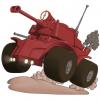Good list you have there. Pretty useful, even though a little bit of gibberish to many european readers (imperial units, doh! ;))
The one point I am not sure about is that Class IV stop everything besides Magnum Pistol rounds... where does this information come from? Form what I read on the internet, type III stops everything up to 7.9x51mm, which is the classical Rifle round used in the World wars... surely a Magnum round fired at half the muzzle velocity will have not more energy on impact than a classic rifle round (might be heavier, but the difference in speed is quite large)?
Class IV seems to be protected against AP ammo in addition, so again, should be able to defeat Magnum ammo, right?
there some new Magnum super Ammo that has this much more penetrative power?
Yeah, it can seem kind of confusing.
That's what happens when NATO, Russia and America all decide to mix and match the naming systems of their rounds.
Real quick, there is imperial and metric measurement for the caliber of rounds.
.308 is the same thing as 7.62x51 and 7.62 Nato, from a purely mathematical point, same as .223 and 5.56x42 and 5.56 NATO, but all rounds, even within their certain types, have different "loads", different individual parts that make em up. The actual bullet may be heavier or lighter, among engineers and gun enthusiasts, we refer to this as the "grain" of the bullet, this is a very fine unit of measurement where 437.5 grains actually equals an ounce. Many also use different quantities of gun powder to achieve different velocities when the round is shot. Funny, isn't it? Which is why I had to explain the M855a1 because your regular 5.56, while weaker than 7.62x51, can defeat level 3 body armor, which ties in with the next point.
I might have explained it wrong but with pistol and rifle cartridges, they both have their magnum class of rounds and classes of rounds.
For pistols its
Small pistol and large pistol, which are almost entirely indistinguishable in everything but the firearm's ability to be converted, IE a small pistol chambered handgun cannot have its barrel swapped out and be able to shoot a large pistol round for the most part, while a large pistol chambered handgun can take be, but not always.
And then you have pistol magnum cartridges which are over grown large pistol rounds. these are .357 magnum, .44 magnum, .50 AE and .500 S&W.
For rifles its
Intermediate rounds. These are like 5.56, 5.45x39, 7.62x39 and that 5.8 retardation the Chinese are using. They're smaller, lighter and you're meant to carry a good amount of it. These are used most commonly in what people call "Assault Rifles." IE Firearms that are capable of fully automatic fire. If its not capable as such, it's just a regular rifle chambered in an Intermediate cartridge.
Full power cartridges. These are like 7.62x51, 7.62x54R or rimmed and .30-06. These are bigger, heavier and most commonly used in actual machine guns and Battle Rifles which is something of a neologism that doesn't really mean anything outside of a different way to distinguish firearms chambered in Full Power rounds from from those in intermediate rounds. Though there is some specifics to them, those being that a battle rifle must be chambered in a Full Power round and be semi automatic and/or capable of full.
Note that there are more rounds of each type than listed, if I were to list them all, I'd be here all day and still not have gotten them all.
Now Rifle Magnum cartridges. These are rounds bigger and even more powerful than full power cartridges, typically to the point where they are able to be moved up a class. The three most typical are .300 Winchester magnum, .300 Winchester short magnum and .338 Lapua. For reference, the .300 win mag has the same sized bullet as 7.62x51 BUT the key different is the case, the brass tube that houses it, in .300 win mag, it's longer, which allows more powder which gives it a net bonus in it's velocity of about 25%, making it go about an extra 200 m/s faster. .338 is similar, only it's bullet is twice as heavy as the lightest 7.62 bullet used in 7.62x51 and .300 win mag, and goes just as fast as the .300 win mag.
Thus the magnum designations. These rounds just go so fast, are so powerful that they are able to defeat our most powerful of body armor. the .300 win mag I mentioned, in order for body armor to sustain a hit from it considering its 25% more powerful than 7.62x51, would mean it'd have to be an extra pound in weight, and quarter of an inch thicker, multiply that by 2.5 for having back and side plates as well. But that also means it won't stop .338 lapua, Assuming that they're not also Armor Piercing as well, this also means that they're only capable of taking a single hit with odds of defeating the round greater than 50% in less than ideal conditions, that's typically what defeat means in the body armor industry.
So in a game balancing situation what should this mean?
To keep with reality, any gun that is chambered in this round weighs 25+ pounds, ammo is INCREDIBLY rare, INCREDIBLY expensive, in america .338 lapua is 5 to 6 dollars a round, making your average box of 20 around 100 dollars unless you reload your own, its heavy, over 4 times the weight of 5.56, but it defeats all body armor for humans, and any mutants or monsters you encounter, nothing but the absolute toughest armor is able to defeat it, and even then is able to take one hit before breaking. This doesn't mean however, that it also absorbs the shock of the round impacting it, without harm, just none of the fleshy harm caused by the round tearing through you.









